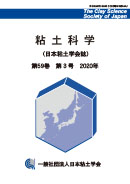
- Issue 3 Pages 60-
- Issue 2 Pages 33-
- Issue 1 Pages 1-
- |<
- <
- 1
- >
- >|
-
Junnosuke Kemi, Tomohiro Yamaguchi, Tomohiko Okada, Seiichi Taruta2020 Volume 59 Issue 3 Pages 60-69
Published: December 25, 2020
Released on J-STAGE: January 05, 2021
JOURNAL FREE ACCESSIn this study, NH4+ ion exchange of Na-taeniolite (NaMg2LiSi4O10F2) powders, heat treatment of the ion exchangers and ionic conductivity of the heat-treated ion exchangers (protonated-taeniolites) were investigated. Coarse Na-taeniolite powder was prepared by grounding Na-taeniolite crystal lump obtained by melting method, and fine Na-taeniolite powders were prepared by ball milling or planetary ball milling the coarse Na-taeniolite powder. Na+ ions in the interlayer of these Na-taeniolite powders were exchanged with NH4+ ions in NH4Cl solution at 90°C. The NH4+ ion exchange ratio was improved by ball milling and planetary ball milling, and the planetary ball milled Na-taeniolite, which had the largest specific surface area in this study, showed the highest NH4+ ion exchange ratio (95.9%). Almost NH4+ ions in the interlayer of the ion exchangers were decomposed into protons by heating at 700°C, and the generated protons combined with apical oxygens that have a larger effective negative charge than basal oxygens. Ionic conductivities of protonated-taeniolites were measured at 400 to 600°C by an alternating current four-probe method. The protonated-taeniolite prepared from the planetary ball milled Na-taeniolite, which had a larger amount of proton, showed the highest ionic conductivity of 7.97×10−5 S/cm.
View full abstractDownload PDF (2902K)
- |<
- <
- 1
- >
- >|